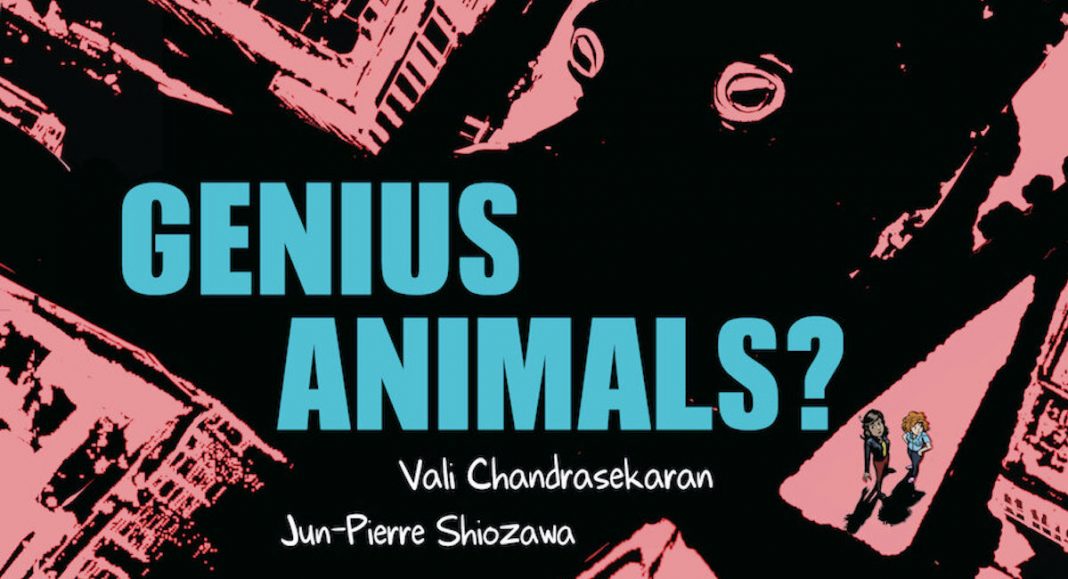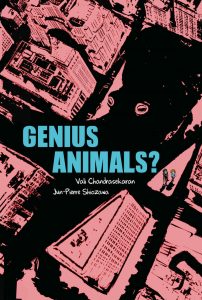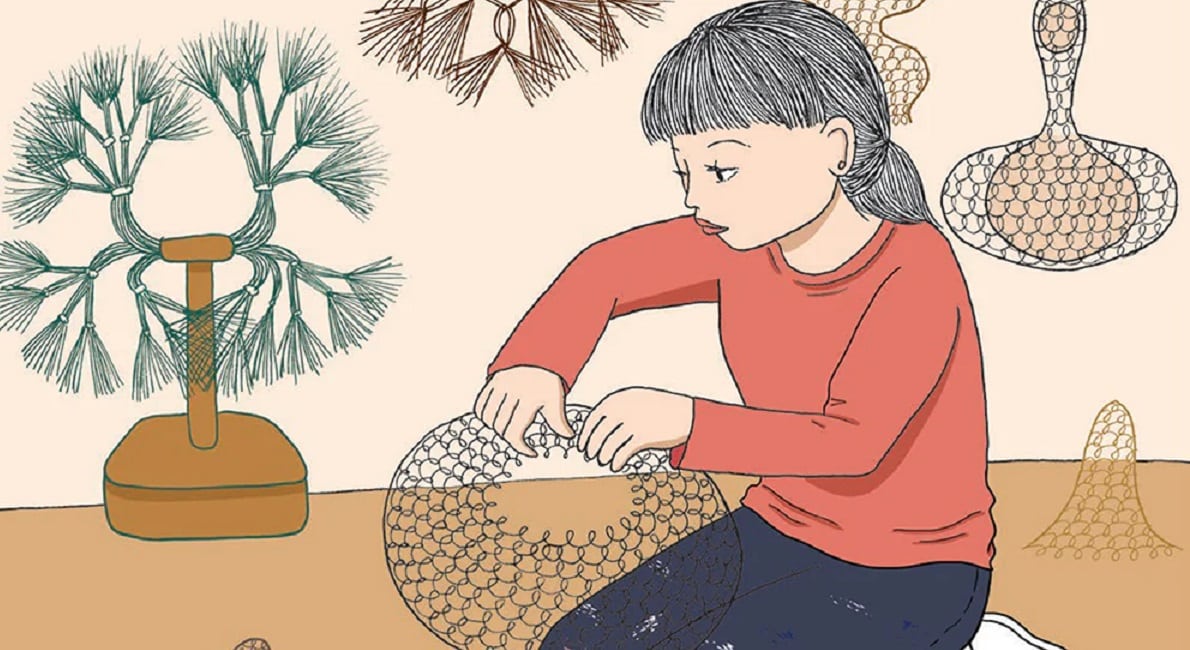Girl meets boy. Girl falls for boy. Boy disappears. Girl and her friend look for boy and uncover a bizarre conspiracy that may threaten the entire human race.
That’s just the tip of the iceberg in Genius Animals? The online graphic novel is the first collaboration between Vali Chandrasekaran, an LA-based TV writer and producer with credits on shows like 30 Rock and Modern Family, and Jun-Pierre Shiozawa, a painter and art instructor living in France. Part romance, part thriller, part buddy comedy, Genius Animals? has been featured by Paul Scheer in a mini-episode of the How Did This Get Made? podcast, and earlier this month was listed in the New York Times as one of ten new comics to check out this fall.
The book is filled with fantastic locales, fascinating characters, and surprising links to real-world events, and to tell you more about the plot of Genius Animals? would be to deprive you of one of the most enjoyable reading experiences of the year. It’s almost hard to believe it’s just the first graphic novel for both creators (and, for Chandrasekaran, his first comic ever).
The Beat had the opportunity to chat with Chandrasekaran and Shiozawa about the genesis of Genius Animals?, what it was like learning how to make comics on the fly, and how a mysterious undersea bloop became a key element of the book.
Joe Grunenwald: Where where did Genius Animals? come from? Was it an idea that one of you had and then roped the other one in, or did you guys develop it together?
Vali Chandrasekaran: I actually first came up with Genius Animals? about 10 years ago. It’s one of those projects that has been bouncing around in my head for a long time that I thought, like, ‘one day I’ll get to this,’ but in reality, I never get any of those. But part of the thrill of doing this book was actually picking something up from that file and following through on it. I was working on 30 Rock at the time, and my wife is like me, she grew up in the United States but had taken a job in India after college. Our hours on 30 Rock were just terrible, like as was a great show, and we took working on it very seriously. So we would work until 10:00 p.m. every night or sometimes even later because I would never make plans with anyone. Because you didn’t want to be the person who, eight times in a row, said ‘let’s get a drink’ and then had to cancel the night out. So I would go home, my wife would be there, and I would want to sort of unwind, and I didn’t really want to watch TV after working on TV all day, so I decided I would start writing.
I wanted to write something that was just fun and different. It was already hard on 30 Rock because 30 Rock was such a big cartoony universe already, so the idea of something that couldn’t happen in that universe was a little bit hard to find. And one thing I realized is, 30 Rock is a hilarious show and we sort of subverted a lot of the tropes of TV on it, and one big one was Jack and Liz never got together. On any major other TV show I’ve ever worked on there’s these two big characters on the show and they would fall in love, and the audience loves both of them, and you would figure out a way to sort of have the ‘will they won’t they,’ and get them together at the end. Tina Fey, who’s a genius of comedy and storytelling was like, ‘I don’t want to do that. I don’t want to do that thing that everybody expects. I want to find out a way to make it satisfying without doing that.’
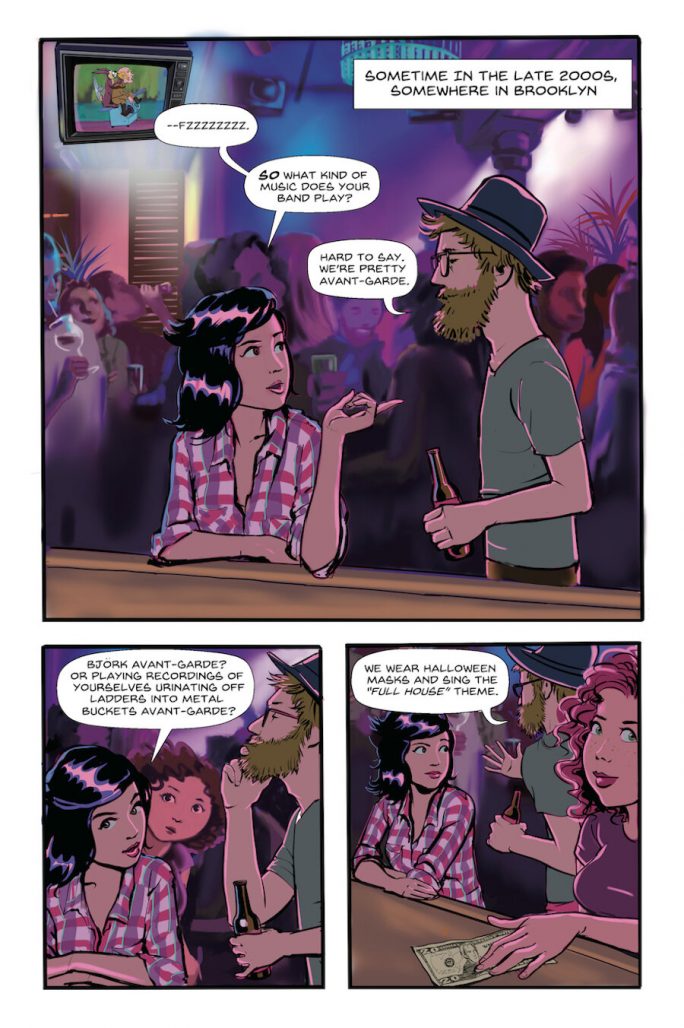
But as a result of that, I had spent a lot of my career not writing about people who were in love and the problems that come up with love. So I start to think, ‘OK, well, this is a fun thing that I don’t really have a lot of practice with. How do I subvert that idea or use that emotion to come up with a bigger story? ‘And I started breaking the story of Genius Animals? and I kind of wanted to write something unfilmable, and I thought, ‘this will just be fun and maybe people will see that I had fun with this and I can get other movie work off of it.’
And then I put it away for a long time – I did use it to get other work – and then I met Jun and I realized that the graphic novel might be the perfect venue for this, because people, when I would send it out and I would get other work, they would say, ‘I like this, I really love it, and you ever thought about making this an animated movie?’ And I would say, ‘I don’t really think so. I like the idea of it feeling like the world we truly live in.’ I would always think about The Matrix and how one thing I loved about The Matrix, because it was a huge conspiracy, kind of built off of feelings like deja vu and weird things that every human being has noticed in their life. And The Matrix is a sci-fi movie landed on another level for me because of that. And I said, ‘if we make an animated I don’t know that it lands in a satisfying way.’
But after talking to Jun a little bit, I started to realize, ‘oh, when you read a graphic novel, even though it’s a drawing, you don’t think of it as necessarily being a cartoon universe,’ like so many graphic novels are just a way of telling a story that is set in reality. And the way we interact with that [form] is, I think, very different than the way we interact with an animated TV show or movie. And I started to get really fascinated by that idea, first academically and then creatively, of what we can do there. And Jun and I started talking for a while and then we started getting into the book.
Grunenwald: You mentioned not really writing people that are in love, and the first chapter of this book is really just a delightful romantic comedy. If that’s all the book had been, I would have been been very happy with it. And I think you played well with the different genres. You’ve got the romantic comedy aspect and you’ve got sort of a thriller aspect to it, and then just a lot of weirdness and strange characters and locations. How did you approach balancing those elements of the story so that one didn’t overtake the other?
Chandrasekaran: Jun would be good for this because he drove a lot of good thinking about this stuff.
Jun-Pierre Shiozawa: Well, that was one of the first things I noticed about the story just as I was reading the script the very first time. Vali and I were talking back and forth, and then he sent it over to me I think it was around like the holidays and Christmas break time. And so I’m reading on this train coming back from Italy, and I was totally engrossed with just how weird and funny and wild it was, and how the two protagonists, the two girls, Alexandra and Finnegan, are always in these different settings. It’s like every chapter there’s almost a new world or new environment that they find themselves in, and there’s usually some leading character or figure that is almost like their guide in that new setting.
It really fascinated me almost how they would have to be, and it doesn’t really take place, I mean, she starts in New York and then there are other places around New York and they then leave New York. But it felt far wider than that, and I think it’s because each locale is so specific, so visually, the potential in that just seemed really interesting and really exciting. I felt like I wanted it to feel or I could see how it could feel like we’re really going on this long journey with them, and all of these different environments and over the journey, Alexandra especially, she changes, she evolves as she learns more and more about this mystery. So I felt like for a script, it was very visual, it had a lot of room to play off, whether it was just the environments, like I said, or whether it was just the diversity of characters. There are some funny characters, some that were a little bit more menacing, the fact that animals played a role, there were some different animal characters. I just thought that was really cool, and for someone like me who likes to just unload with different visual shapes and forms and figures and characters. It just seemed like, ‘wow, this could be such a fun project, it’s just exciting to get a shot at.’
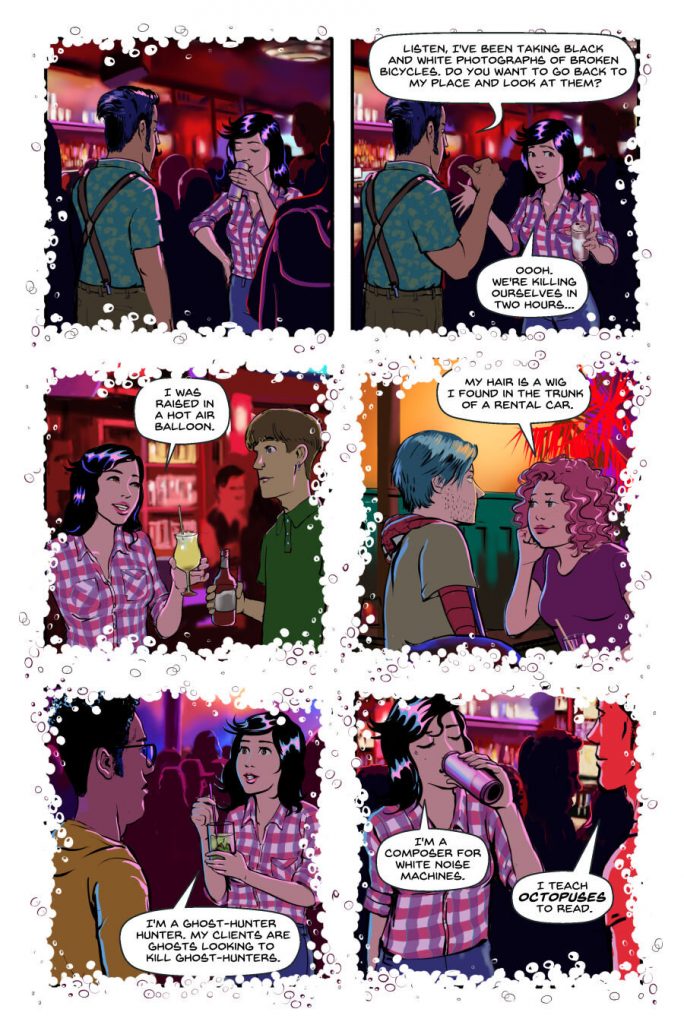
And what’s wild is that I haven’t really been doing comics, at least not at this scale, in years. The way that Vali and I actually met was through Vali’s wife initially. Vali and his wife, they took one of my watercolor workshops in Ireland. I’ve been teaching watercolor painting, oil painting, and it’s just like a completely different domain. I did some Inktober sketches, [and] Vali was able to spot that it was like an itch that I still wanted to address, but it wasn’t really in the forefront of my mind, and he basically kind of saw that. I thought that was something that was really interesting, intriguing for me. And then as we started to get the ball rolling, it was just like, OK, yeah, let’s let’s do this.
Chandrasekaran: I remember at the time I was really into The Big Lebowski and the sort of episodic comedy of that movie. In that world, there’s this mystery, but you see his landlord’s modern theater piece and also Jackie Treehorn and the nihilists, there’s so many big worlds within this one normal guy’s life, and him getting to go on that journey was so fun, and I really loved that movie and wanted to do that. I was also, I had reread The Crying of Lot 49, that Thomas Pynchon novel recently. I love the tone of those things and how funny they were. I was obsessed with narrative and what that means to us at the time. The Crying of Lot 49 was obsessed with communication, which is very similar to that, and I really liked those things.
I remember when I saw those Inktober sketches from Jun, they were about his family, he’s half-Japanese and half-French, and they were snapshots from his mother and father’s life. And I remember looking at them and thinking, ‘oh, these are so beautiful, and they’re so specific, but also so universal.’ Like everybody feels like, ‘my mom and dad’s families are so different.’ And then the specificity of it made it really true to Jun, and the images he chose and moments he chose were so fun. I could just tell we were going to be simpatico on what we want to see in this story.
Grunenwald: I wanted to ask what your collaboration was like. It sounds like, Vali, if you’re an artist yourself you must be a pretty visual thinker. Is that accurate?
Chandrasekaran: That is not accurate. (laughs) My wife knows Jun because she and Jun went to art school together at this place called The Aegean Center in Paros, Greece, that Jun later became a faculty member of. I like art but I had not painted since high school art class. We had two-year-old twins and had kind of not left the house in a year, and Jun started offering these classes of landscape watercolor painting where you go to Galway, Ireland for a week. And it came to me and my wife, and she said, ‘when was the last time we just looked at something beautiful for a while? If we could do this, our minds would just be doing something that’s not figuring out the feeding schedule of our children, and do you think we could get our parents to come?’ So we did that. My parents and my wife’s parents live on the East Coast, and we all went to Ireland, and my wife and I took this class. I had not painted since I was a child, but it was really fun and I thought Jun was a great teacher, so we kind of became close during that.
Shiozawa: Also, Vali’s paintings were awesome. I mean, we went to the Cliffs of Moher, which is like this crazy, gorgeous, scenic, it’s in all the Irish tourism campaigns. We pretty much would be sitting right on the edge. And that is, as far as painting from nature, pretty much as advanced as it gets, and you just knocked that out. And I think that was like day two, day one or day two if I remember right.
Chandrasekaran: That’s very sweet of you, but it was also a moment where, like, it was kind of an intense artistic experience, just taking your class, and we learned to communicate with each other via you teaching me to paint in a way, that I feel like informed us working together on the book. That class was one week long, and that’s all I knew Jun. And we kind of built a working relationship off of that that was basically seamless after that. There weren’t really bumps afterwards.
Shiozawa: Yeah, that was it. It was a week long. And then you basically went back home to L.A. and I went back home to Nice, and then after almost a year we reconnected.
Grunenwald: So was this a thing where, Vali, you had the full script done and you approached Jun with it, or was it more a collaboration and developing the story and then actually putting it together?
Chandrasekaran: I would say both. The full script was done, and I knew nothing about comics, so I did not write it in a way that you’re supposed to write a comic. I had only known about comics as a fan. So I said, ‘I have this idea that I think could work,’ and I showed it to Jun, and Jun sent me back sketches of the way he would break it, like very high level sketches. And I didn’t, to be perfectly honest, know what I was really looking at, understand how to think about them.
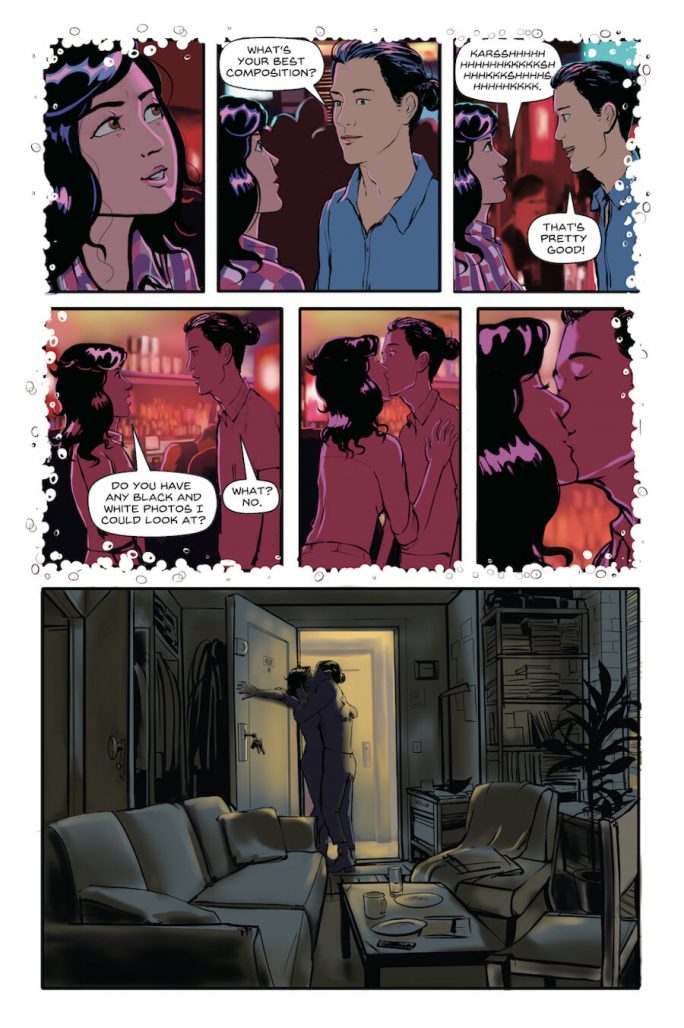
And so I think that early on I said, ‘oh, this makes sense to a lot of stuff that I wasn’t quite sure about,’ and I either became convinced by it or we went back and forth and we just kind of iterated it. And I’m very used to that from the TV world because, you know, you break a story, turn in an outline, you get notes, you change that, you write your first draft, you get notes, you sometimes a second draft, you bring it in, everyone rewrites it going through every line. I mean, it’s a very much a process where you don’t worry about any moment being perfect because you’ve worked together for a while and trust that you can get it to the place you want to.
But by the end, based on that first script, we worked we worked on it together after that for a long time to the point that, Chapter One, we released it and then the next week decided we could make stuff better, and Jun made some changes and redrew some stuff, and we were redrawing stuff and reworking dialogue until we launched most of it. And I think if we do a print version, we’ll probably do another pass on it.
The one nice thing about being online is, there’s no end date for it. We would talk about when Kanye released Life of Pablo, he would release songs and rewrite them and re-release them. I remember that blowing my mind of when an artist’s work is done.
Shiozawa: One thing that was really cool, and I felt it pretty pretty much from the beginning, was, both of us were coming, even though I had, I guess, a little bit of comic book background in a sense, like I had done some of my own personal comics and I self-published a couple of books way back in the day, [but] for the most part, I was coming at it totally from left field, and so was Vali. And so both of us were sort of joining in the middle of just trying to put in our own attempts at putting together a fully completed graphic novel. And so I thought it just seemed like we were, in a lot of ways, going from our own gut, you know, from things that we like, things that we’d seen. There was definitely no formula, I mean, as far as how we worked together, it was just how best it was for us to just move the project along.
So, for example, whether it’s rewrites or drawing pages again or making sure a joke works or a certain look or things like that, we were just playing off of one another, and I though that was really cool because we had to just really trust ourselves, and also there was less fuss. It was just like, ‘alright, we’re just going to just keep going until something doesn’t feel right. If it doesn’t feel right, say why it doesn’t feel right.’
I knew that, at the end of the day, we wanted to have something that we could put out there, release, and it could be up against any other book. But I also knew, we’re totally new to this, so let’s just try to use that energy as well and see where it could take us. And in a way, I think we’re kind of still on that trajectory, we’re still pretty new to all of this.
Chandrasekaran: Learning about comic comic timing was the most interesting part of it, because that was something I cared a lot about, given the sort of thing I like to read and I like to consume. And there would be times where I didn’t really know why a joke wasn’t working. And sometimes on set, you will be able to go to the actor and say, ‘this isn’t quite funny. What if we try it this way?’ Or you could try a different line reading or you go to the actors, we can change the angle, are we too wide, are we too narrow, or editing yourself sometimes. And in comics it was a totally different language, and it was just trial and error. And sometimes I’d be reading other books and I would see something funny and I would send Jun a picture, and sometimes Jun would just try drawing things a couple of ways until we finally said, ‘Oh, it’s funny that way.’ Or I would say ‘maybe this joke just doesn’t work. So we should cut it. I’m sorry you had to draw all of this and make your panel in this way, but let’s blow past this because I don’t want to live in it.’
One example I remember is Ed O’Neill on Modern Family. I think he’s so funny because he throws the joke away a lot of the time. Instead of, like, really telling you, this is a punch line, he throws it away. And it took me a while to figure out how to throw away a joke in a comic. And we sort of figured it out a little bit eventually. And then once we did it, it just started happening automatically, like it just became part of our process of how Jun’d draw it the first time.
Grunenwald: I want to ask about the bloop. Which came first, the story and then you incorporated the bloop, or was the bloop something you knew about and then you wrote around it. How did that come to be part of the story?
Chandrasekaran: The bloop was something I’ve known about for a long time. (laughs) I was fascinated by the bloop when it came out. I used to listen to Coast to Coast — Sea to Sea [a fictional radio show featured in the book] is based on this radio show Coast to Coast that Art Bell used to host for years and George Noory would host afterwards, and I always loved listening to that radio show. It was just about the paranormal and conspiracy theories. They would play it from like 10 PM to 2 AM in L.A., and in New York I would subscribe to the website and play it in the background sometime when I was home. And it was so funny because all of the stories are so crazy. It’ll be like a guy who was abducted forty-seven times by aliens and Art Bell or George Noory saying, ‘you know, I’ve had my own experiences and sometimes you’ve got to make sure you’re not just having a normal out-of-body experience and it’s a real abduction,’ and then he’s really engaged and he’s really serious.
And then other times someone will be coming in and just saying, ‘I think I’m the reincarnation of John the Baptist’ or something like that. And you can tell Art Bell thinks, ‘oh, this is a crazy person, I think everything he says is crazy.’ He thinks, ‘this guy is nuts and it’s demeaning to my show that I have to put this guy in with all the real conspiracies that I’m shedding light on.’ I would think it was so funny, and I think I heard about the bloop there or, via that world, one day found myself on the National Oceanic Administration’s website. And back when I came up with the story, they had not come out and said [the bloop] was glaciers collapsing. Then, the main thing was one scientist had said it sounded animal in nature, and then they weren’t talking about it anymore.
Grunenwald: OK, so they have explained what the bloop is.
Chandrasekaran: In 2013 or 2014, they said they really think now it was a glacier collapsing, but another scientist had said beforehand it doesn’t match that pattern closely enough. So it seemed like a cover up.
Grunenwald: I loved being able to go and listen to the bloop, because I did that immediately when I got to that page and you had the URL. I really appreciate that. It’s an interactive book.
Chandrasekaran: We figured, that was one thing that was really fun about putting it out online, is that we could we could send people there rather than in the print version. We thought, like, this is such a long URL. Should we do a condensed URL? But then no one will believe it’s real. You need to see that it goes to a real US government website.
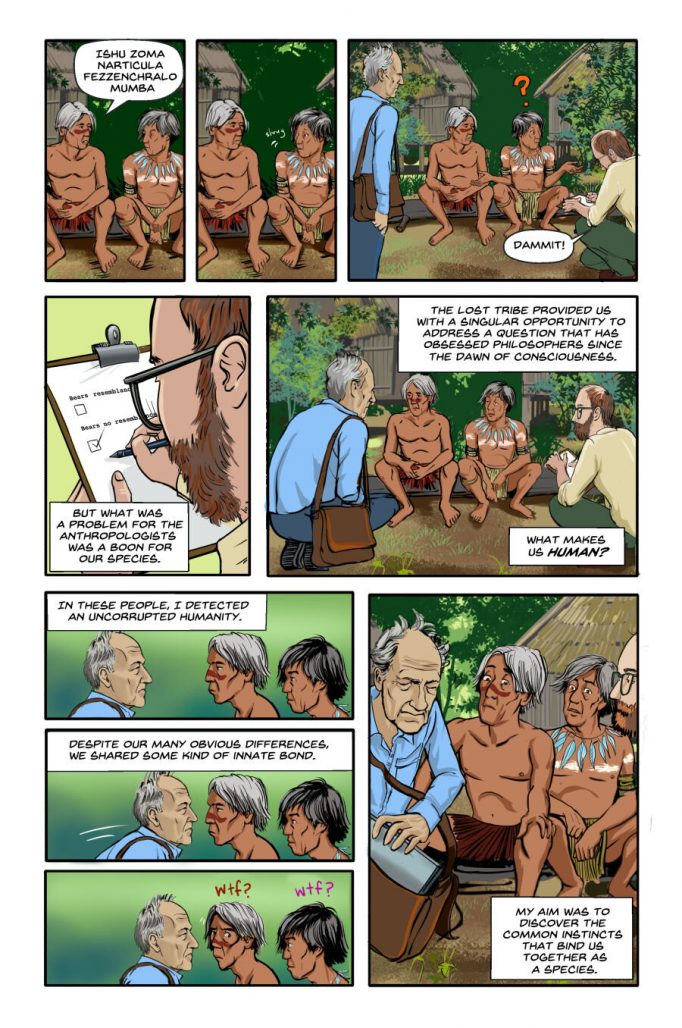
Grunenwald: Jun, I wanted to ask you about the art on this book. I love the way that it looks, the way the characters are rendered, and how they sort of pop out like they’re in a little sharper focus than the softer focus backgrounds is really cool. It keeps the focus on the characters really well. I know you’re a painter — did you fully paint this book or did you use a combination of different mediums?
Shiozawa: I actually did it almost entirely digitally using Clip Studio Paint. At the very, very beginning of the project when Vali and I were just trying to get a feeling for how it might look and the character designs and everything, I was thinking that would be great if it was fully inked and painted, maybe something along the lines of what I did for that Inktober project, but soon I realized just how much longer that would that would add to the entire timeline, just little things like edits and scanning and resizing and stuff like that. I was really intrigued with certain artists like Fiona Staples, for example, the way that they were able to be both. Instead of just the work flow of pencils, ink and color, where almost everything is integrated in one — it’s almost as if you could start with the color and then add the inks on top.
So I was thinking about that a lot as far as just how to approach the workflow, and because of that I think I was able to solve some visual problems and also kind of help with the storytelling visually, depending on the setting, depending on the scene, kind of have more dominant colors. And so it is yet another thing, like I’m much more of a traditional painter, so that was another thing I was kind of learning on the fly and just kind of getting a feel. That’s why the first few chapters took way longer than the last four chapters. I think that’s pretty common for most comic book artists.
Chandrasekaran: I remember Jun showing his very first sketches, that he had the vibe down already and I was imagining something a little bit closer to his Inktober work, which is what I was expecting. But he showed me a bunch of stuff, and, you know, obviously the Fiona Staples was really transfixing and he was thinking about it a lot. And I remember one of the very first sketches he showed me was Give Me Death, the conspiracy theory bar, and just the vibe in there…It was so rad. I was so into it. And then the other section was that romantic comedy montage at the beginning, which was one of the first set of pages. You can see how he would go from that romantic comedy beginning to this weird world within one style and be able to transition within it. I was so happy when I saw those.
Grunenwald: I love that montage in particular, the level of the silent storytelling is so strong there. And the bar is probably my favorite location. It’s so lived in and every person, every little group there, I feel like has their own story. And it all just feels so fleshed out. It’s so great.
Chandrasekaran: I love that section, too. I feel like we could have done weird fringe groups for like seventy more pages. (Laughs)
Shiozawa: One thing that I have to say, speaking of the bloop and the opening love story. Obviously we all read comics, we’re used to how comics work, how it’s only visual, but you have to use these different techniques and methods to convey sound and rhythm and time and all this other stuff. In the original script, there was audio or a dialogue happening over the montage. And I remember how much I liked that. I thought the conversation that was happening was really a beautiful conversation or was really sweet, and just thinking about how to kind of translate some of those words into imagery, not necessarily literally, just like the feeling of those words.
As we developed the story, as the book moved along, we realized that actually maybe we’re not going to have that dialogue overlayed because it was just a little bit confusing. But I kind of missed that because that was a guiding way for me to think about the illustrations overall. And you’re trying to, you know, storytell, move the story along panel to panel, but also just try to infuse the images with the words, with the way that the back and forth and the banter and all of that feels. That’s something that I was thinking about a lot, and I feel like I’m seeing that a lot when I look at other books or other artists. The voice of the writer and the voice of the artist have to play off one another in that way. And when it really feels almost seamless, you can really tell it’s because the writer is aware of how the artist draws or renders or designs, and the artist is aware of the beats and the pauses and everything that happens within the text, to make everything feel natural and organic.
Chandrasekaran: Yeah, I remember when we realized that we can all of the words away and make that montage play totally silent, how great that was.
Grunenwald: It’s such a cool sequence, and I do feel like, reading it, you can absolutely hear the characters, like when they’re in the diner and they’re stealing each other’s food. My wife and I do that all the time. I mean, not grab eggs and shove them in my face, but you know what I mean? So much of that is so relatable, and it’s such a great sequence.
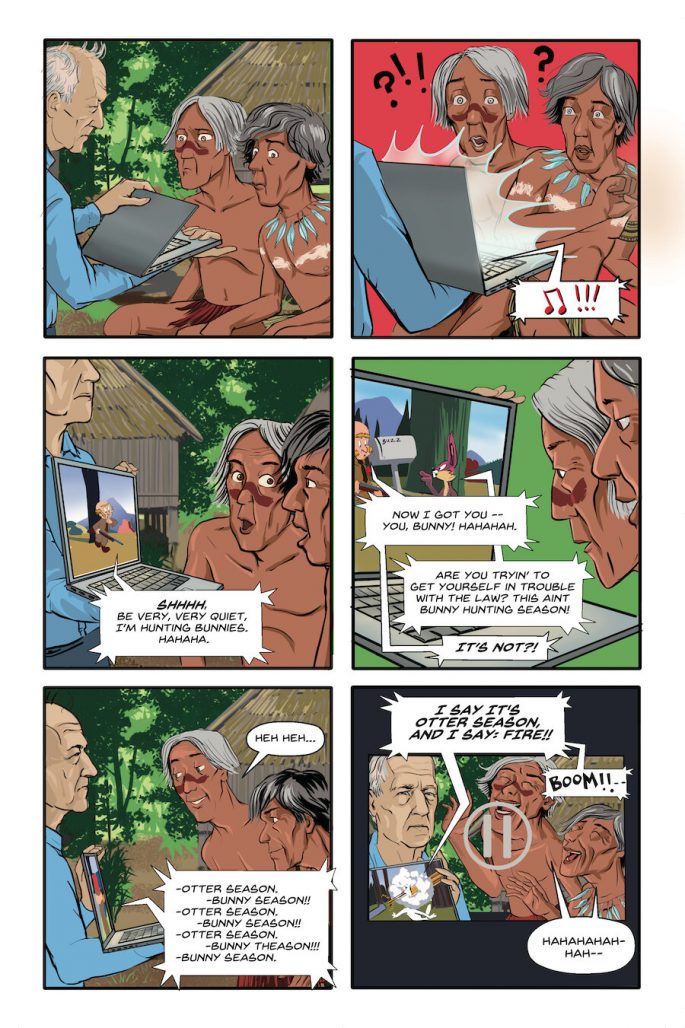
I wanted to talk to you guys about the way that Genius Animals? has been released. All eight chapters are online now. Why did you choose to do it online, and to do it in that week-to-week format?
Chandrasekaran: (through laughter) It was always the plan. We’ve really been methodical about this the whole time.
Grunenwald: I don’t believe you.
Shiozawa: (deadpan) We had it all written down. We have the notes.
Chandrasekaran: We mailed it to ourselves in a self-addressed stamped envelope. (laughs) No, we were going to put it out as a book, and Jun showed an early draft of it when we went to Thought Bubble in Leeds, England, and it was very touching, the response. We were moving forward with that, and then the pandemic happened and no one knew when we were even going to be able to print, and no one knew how two people who had never worked in comics before would ever be able to promote a book. And already publishing has these long timelines and that was adding additional uncertainty to it.
And we were going insane at home. And we had this story and this book that was burning a hole in our hard drives, and we kind of just we’re like, ‘well, what if we put it out online or we put it out on GumRoad,’ which we started talking about different ways to put it out. We even talked about changing it to incorporate the pandemic, if that would give it more immediacy. We just wanted to put it out and get it out there, and part of it was just our pandemic energy, and we thought, ‘well, let’s try, it will give us something to do, and what if we released it one chapter every week, even though we had chapter breaks but we didn’t think of it as being issues like that, and let’s see what happens. Let’s experiment with this. We’ve been experimenting the whole time, and let’s experiment now. And maybe other people are going insane as well and wouldn’t mind a distraction.’
We decided against changing it for the pandemic just because we wanted it to be a break from what was going on in the outside world. And we just tried putting it out that way, and I think we’ve been very happy with the results. Like I said, coming from the TV and movie comedy world, I have a lot of friends who like comics, but I also have a lot of friends who like just comedy in general and don’t necessarily drive to their specialty comics shop every once in a while to check out what’s new, but because they were able to just go to the website and scroll, [they] were able to read the whole book and were really into it in a way that was really touching to us. And it actually was a little bit harder for us to get it out to the comics world because we don’t know as many people in the comics world. That’s why we’re so touched by people like Paul Scheer who read it and liked it and plugged it for us and stuff like that.
I say so far the experiment has felt like a success, and that we did get it out to a lot of people, probably a lot more eyeballs in a short period of time than would have seen it had we had it in a very small place, a very small press, especially given that we can’t just go sit around at cons and show it to people right now because of the pandemic.
Shiozawa: It just felt like with all the craziness, that we’ve been living through the past few months, we just we’re not at all sure or clear about what was going to happen with this earlier plan that we had to release it by a small publisher. You know, everybody’s home, everybody is just in a state of mind where we’re just so tired and exhausted from the daily news. And we have something in a way, we have something that we we want to share, so we should just share it and we should share it as purely as possible, in the sense that we just, you know, put this website together and it’s pretty bare bones. It is what it is. It’s just the pages, I think there’s the ‘About’ page, and that’s about it. We considered, should we put it on Tapas or Webtoons or GumRoad, and it was like, ‘let’s just put it out there and see what happens.’ It definitely wasn’t like we we didn’t consider all those options, we’d have long, long conversations.
But really, it was very much par for the course for the rest of the project that we were going on our own gut feelings and how we felt about it, what felt right, and said ‘alright, let’s just go for it and just try it that way.’ I know in the future looking back on this project in retrospect, that’s one thing I’m going to take from it. Just, you know, just keep going. Trust yourself, trust your collaborator, because you’ll feel good about it. Like, I feel really happy with how that worked out, because I knew that every step of the way I’ve been very much on board with the decisions.
Chandrasekaran: The pandemic almost helped us put it out like this, because we were going out to cons and we were at a table and nobody was buying our book. That humiliation is really closely felt. (Laughs) But if we put it online and no one goes to it, well, then no one’s seen it, so it was almost easier to take because, well, we tried this and it doesn’t work well, it didn’t burn an option for us, and it felt a little bit less humiliating, even though getting the word out was a lot of work.
And then the second thing I wanted to chat about quickly was, to Jun’s point of like trusting your collaborator and figuring this out, part of what was fun about this project was, I’m now 15 years into my television and movie career, and I literally missed not knowing what I was doing and stuff happening by mistake, sort of surprising me. And I really loved getting to do this book, and I almost recommend switching genres to any person in a creative field just to kind of shake your brain up and remind yourself, ‘oh, yeah, all those rules that you learn that actually make you better at your job and make you faster and make you get to something interesting quicker, it also can start to constrain you.’ And it was really, really fun to remind myself, sometimes you should just blow it wide open and not know what you’re doing and kind of surprise yourself, and that is why you got into writing jokes in the first place.
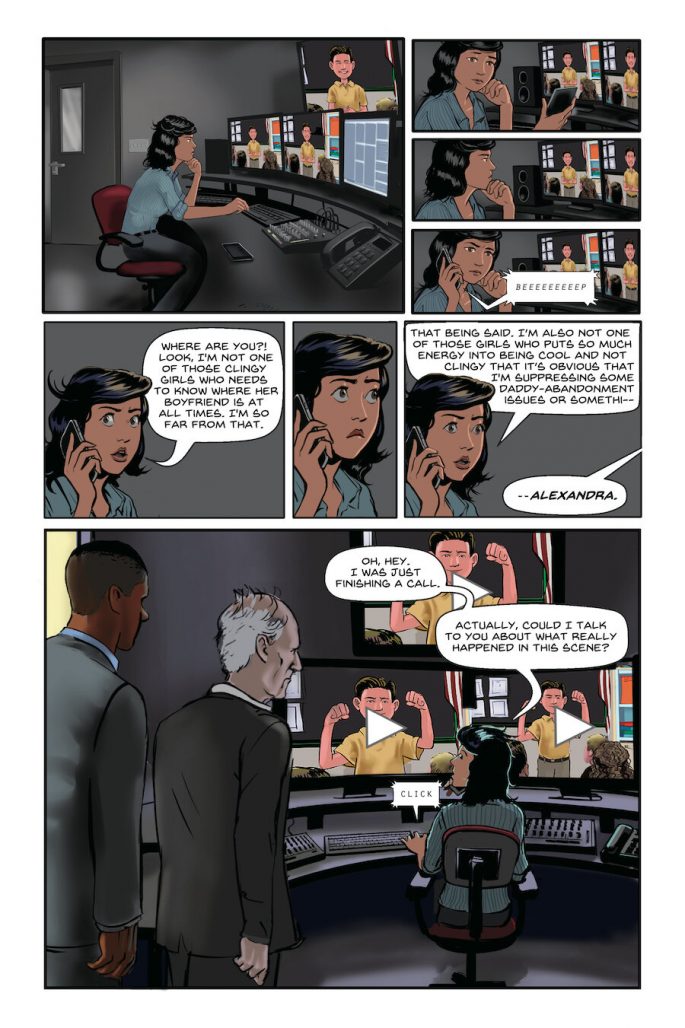
Grunenwald: You said that originally the book was planned for a physical release. Do you have still plans to put it out physically, a publisher lined up or anything?
Chandrasekaran: No one is lined up, but I think we would like to put it out physically, and people have been asking us about it a little bit, which is nice.
And I think, you know, when you’re our age you grew up liking comics that you bought physically at the store. As much as I like how it looked on the website, it’d be nice to crank up that DPI and let everyone see how cool the art really is and how fun it is to flip through there. There’s a spread at the end that I think looks so awesome, in even the books that we printed ourselves just for editing. I think we’ve got to figure out exactly how to do it, but I think I think we’d love to do that.
Shiozawa: Just to piggyback on that, as Vali mentioned, when I went to Thought Bubble last year, I had the finished book, it was an earlier version, but it was pretty much the full book and I was showing it, I just had maybe two copies that I was showing around, but mainly just to see some UK-based publishers. I was meeting a lot of people that were tabling and they had these amazing comics, zines, you name it, and they were so perplexed that we weren’t tabling. ‘What are you doing, you have a book, why didn’t you decide to just self-publish like a very small print run and just have a little table. And honestly, I was just sort of taken aback. Like, ‘no, this is my first time coming here, I haven’t done this type of thing in years.’ I was just really going to get some input and learn. And they would, like, shake and wave the book back at me and be like, ‘This is it. It’s done. You got to just show it.’
I remember that feeling of just looking at the book as it was, and these people that I just met basically just being like, ‘What are you doing? Just put it out there.’ And it was kind of a kick in the pants, because they’re like, ‘yeah, that’s what everybody else here, that’s what they’re all doing.’ Some are published, some are self-published, some of them just went to like a copy machine and printed out a bunch of zines and stapled them, and there is something about the spirit of that that I love. And I feel like I could see that happening, something along those lines, because the book is finished, and the book has been a labor of love and we stand by it. So just to have it be held by somebody and kept on a bookshelf, I think that is really something that I hope we can get to at some point.
Chandrasekaran: I like the idea that artists make stuff, they put it out, and then they go make their next thing. They don’t fix it up, they don’t sit there driving around with their last thing for too long.
Shiozawa: Yeah. I’ll never forget, at that same festival, I bumped into Declan Shalvey, and we have a mutual friend, Phillip Barrett, who illustrated Savage Town, one of Declan’s books. And he was looking at it and I was asking for feedback on the book, ‘Should I change this, is there anything?’ And he was like ‘No, man. It’s done. Work on the next book. That’s it. You’re done. This is a finished book. Next book.’ And I think there is something to that, just keeping that momentum going and. You know, there’s so many reworks you could do, but also like gotta just let those creative juices flow and if you have something else on the burner, just start working on it.
Grunenwald: That sort of leads me to my next question, which is, what’s next for you guys? Are you planning to do any more collaborating or maybe even anything set in the world of Genius Animals?
Chandrasekaran: I would like to do something new, I’m at the moment writing a TV pilot, which is taking all of my time, but Jun and I are talking. We’re going to do something again. I have a feeling it will not be Genius Animals?. And I kind of want to do something different just to keep up the ‘surprising myself’ of it, but we don’t have anything just yet.
Shiozawa: That story or that project from Inktober, which is about basically how my parents met, that’s sort of my ‘always on the back burner’ project I’ve just been meaning to get to one of these days, because it’s going to basically be sort of like a biography of my parents, and Inktober was just like a tiny, tiny little outlet, just to get some drawing started for it.
Chandrasekaran: I would love that. I would love to read that. Comics memoir is such an impressively, amazingly strange genre. Fun Home, the first time I read that, I just thought, ‘I’ve never seen anything like this in my life, I loved it so much.’
Shiozawa: Yeah, I mean, the thing is, the fact that they’re getting up there in age and they are incredible resources, so it’s kind of like, I’ve just got to do it, I’ve gotta get off my butt and do it. Sometimes I think a lot of it is deciding to commit on something when, you know, you gotta bring home the bacon, you’ve got families to support, stuff like that is it’s hard to justify it sometimes, but anyway.
Grunenwald: Yeah, that makes total sense. It’s a large commitment to sit down, especially the art side of making a comic is a big time commitment. Is there anything else that you guys want to add about Genius Animals? or just about what you what you enjoyed about working on it?
Chandrasekaran: I love the freedom, the freeing part of it, and I feel like comics is such a large genre that the only thing I want to add is that I wish every weird, funny person on Earth would find someone to make a comic with and make a comic, because I want to just read more weird stuff. Make more weird comics.
Shiozawa: I cosign that.
Genius Animals? is available to read on its entirety online at geniusanimals.net.


